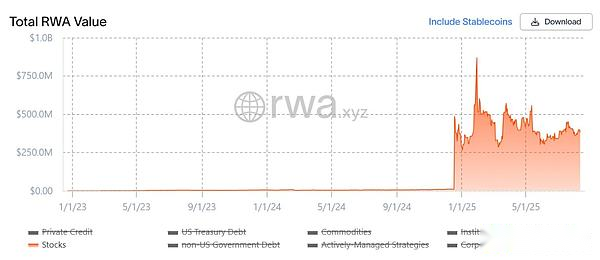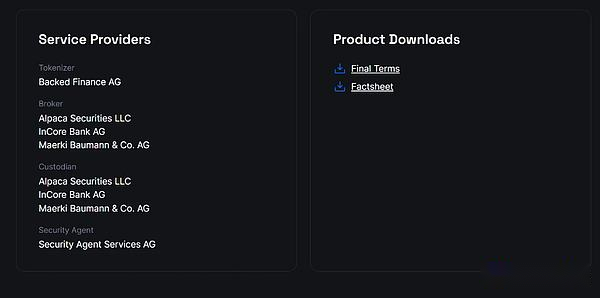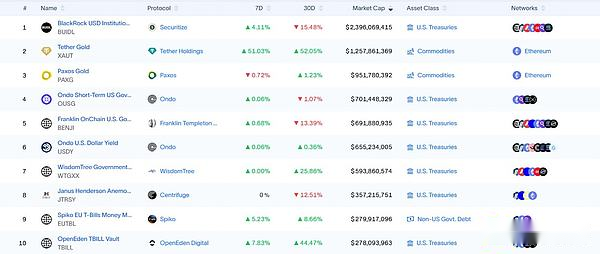
Author: imToken Source: X, @imTokenOfficial Compilation: Shaw bitchain vision
summary
This article outlines the development history of stock tokenization and future trends, especially the so-called “second growth curve” of derivatives and liquidity.
Stock tokenization is becoming one of the most compelling narratives in the intersection of traditional finance (TradFi) and Web3 in 2025.
According to rwa.xyz data, the market capitalization of tokenized stocks has grown from almost zero to hundreds of millions of dollars this year, thanks to the shift from early synthetic models to actual stock custody and increasingly toward more advanced products such as derivatives.
This article will explain the evolution of this model, introduce key players, and explore possible future development directions.

1) The road to tokenization of US stocks
What is stock tokenization?
In short, it presents traditional stocks as digital tokens on the blockchain.Each token corresponds to the share of the underlying asset.These tokens can be traded around the clock on the chain, overcoming the time zone and trading venue restrictions of traditional markets, opening the door for global investors.
Stock tokenization is not new.In the last cycle, projects like Synthetix and Mirror built on-chain synthetic asset systems.Users can use over-collateralization (e.g. SNX, UST) to mint and trade stock tokens (e.g. TSLA, AAPL).
The model later expanded to fiat currency, index, gold, oil and other assets, and settled through oracle pricing and on-chain matching.Since there are no real counterparties (only price exposures are provided), the system theoretically provides deep liquidity and low slippage trading.Settlement with on-chain matching.Since there is no real counterparty (it only provides price exposure), the system can theoretically provide deep liquidity and smooth trading.
limitation: Synthetic models do not convey true ownership of underlying stocks – they are mere price exposure.If the oracle fails or collateral loses its peg (such as UST), these systems may face liquidation, price deviations and trust crises.

How is it different now?
Today’s momentum is driven by off-chain models holding actual stocks and issuing 1:1 on-chain tokens.There are currently two main paths:
-
Third-party compliance issuance, multi-platform access (e.g. Backed Finance/xStocks):
xStocks acquires and escrows shares through partners such as Alpaca Securities LLC.
-
Broker-led closed loop (similar to the Robinhood model):
Licensed brokers acquire stocks and issue tokens on their own, covering the entire process from purchase to on-chain issuance.
The key upgrade lies in verifiable real-world support.This improves security and compliance, making the model more acceptable to traditional institutions.
2) Project Overview: From Issuance to Transaction
A complete tokenized stock ecosystem usually includes:
-
Infrastructure: Basic chain, oracle and settlement track
-
issued: Regulated or compliant issuer
-
trade: CEX/DEX, DeFi (borrowing and other derivatives venues)
Infrastructure is maturing, and the most intense competition – ultimately dictating user experience and liquidity – takes place in the issuance and trading spaces.Here are some representative projects.
Ondo Finance – Extend from RWA bonds to stocks
Ondo was initially recognized by tokenizing Treasury and bond exposures (e.g. USDY, OUSG), and it remains one of the largest RWA platforms.

Recently, Ondo has entered the stock market, working with regulated custodians and clearing agencies such as Anchorage Digital to hold actual U.S. stocks and issue corresponding on-chain tokens.This approach provides compliance guarantees for institutions and creates a cross-asset liquidity pool that enables tokenized stocks to interact with stablecoins and RWA debt.
Ondo and Pantera Capital also announced plans to set up a $250 million fund to support the RWA project.Ondo’s chief strategy officer Ian De Bode said the fund could be used to acquire stocks and tokens from emerging teams.
Injective – Blockchain built for real-world financial assets
Injective positiones itself as a high-performance financial blockchain with native order book matching and derivative modules.Its ecosystem covers more than 200 projects, including decentralized exchanges (Helix, DojoSwap), lending platforms (Neptune), RWA participants (Ondo, Mountain Protocol), and NFT markets (Talis, Dagora).
RWA has two outstanding advantages:
-
Rich asset types:Helix and other applications have listed tokenized U.S. technology stocks, gold, foreign exchange and other assets.
-
Traditional financial connectivity: Cooperation with companies such as Coinbase, Circle, Fireblocks, WisdomTree, Galaxy, etc. helps combine off-chain custody and clearing with on-chain issuance and transactions.
The result is a low latency, low cost execution environment that supports collateralization, composability and ultimately develop more abundant stock-linked products.

Backed Finance – Compliance priority, multi-market coverage
Backed Finance operates under the Swiss legal framework that complies with European MiCA regulations.It issues fully collateralized tokenized securities and cooperates with companies such as Alpaca Securities LLC for stock acquisitions and custody, ensuring off-chain assets maintain a 1:1 mapping relationship with on-chain tokens.
Backed covers U.S. stocks, exchange-traded funds (ETFs), European securities and select international indices.This provides investors with a single on-chain platform that allows them to gain access to multi-market, multi-currency investment opportunities, such as combining U.S. technology stocks, European blue chip stocks and global commodity ETFs without being subject to traditional trading venues and time constraints.
Block Street – Unlocking the liquidity of tokenized stocks
Block Street focuses on borrowing and lending with tokenized stocks as collateral.Holders can use assets such as TSLA.M or CRCL.M as collateral to borrow stablecoins or other tokens to unlock liquidity without selling the assets.
Its beta version has recently been launched, enabling tokenized stocks to serve as available collateral, filling a key gap in the decentralized finance (DeFi) lending space.If lending, perpetual contracts and options mature on the platform, they could bring a “second curve” growth to the entire category.

The biggest advancement in this wave is the combination of actual stock custody with low friction access.With just a wallet and stablecoin, anyone can invest in U.S. stocks on DEX—no brokerage accounts required, no time zone restrictions, and fewer geographical barriers.
However, most products are still in the credentials phase: they issue and trade tokens, but have not yet fully converted them into financial building blocks for trading, hedging and fund management.This would pose a challenge if the goal is to attract professional capital flows, high frequency liquidity, and institutional participation.
Before the arrival of “DeFi Summer”, DeFi also experienced a similar stage.Ethereum (ETH) was not widely used as collateral and portfolio assets until the advent of lending agreements.Once Ethereum becomes an acceptable collateral, liquidity increases dramatically.Tokenized stocks may also need to go through the same transformation: becoming collateralized, tradable and comboable assets.
If the first growth curve represents the volume of goods transactions, the second growth curve will be driven by capital efficiency and activities driven by financial instruments.Expected to appear:
-
Lending and credit-backed by tokenized stocks (e.g. Block Street)
-
Short-term exposure and hedging instruments (reverse tokens, perpetual contracts, options)
-
Structured strategies and portfolio products interoperable in DeFi
A platform that provides a unified on-chain experience (spot trading, shorting, leverage and hedging) and makes tokenized stocks available in lending, options and stablecoin protocols will have a competitive advantage.
Summarize
Tokenizing U.S. stock and exchange-traded funds (ETFs) is not just about introducing Wall Street into blockchain, but about bridging the last gap between traditional capital markets and blockchain.
From ondo to Backed Finance to liquidity unlocking, the structure of tokenized stocks is steadily forming.As institutional engagement expands and trading infrastructure matures, tokenized stocks that are combinable, tradable and available as collateral may become one of the most influential and value-added asset classes in the RWA market.







